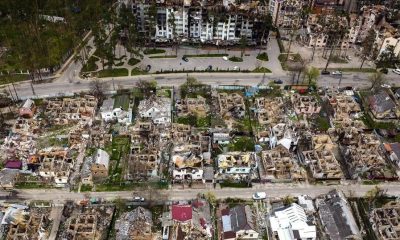Emergency crews rushed to restore power and clear roads on Sunday a day after a deadly and destructive storm swept across southern Ontario and Quebec.
The true toll of Saturday’s storm is still unclear, but police say at least seven people died from falling trees in the strong winds while an eighth died when the boat she was in capsized on the Ottawa River near Masson-Angers, Que.
As of Saturday the known victims in Ontario included a 44-year-old man who died in Greater Madawaska west of Ottawa, a woman in her 70s out for a walk in Brampton, a 59-year-old man on a golf course in Ottawa and one person killed in their camping trailer near Pinehurst Lake in Waterloo Region.
On Sunday, provincial police said the storm had also caused the death of a 64-year-old woman at a home in North Kawartha Township and a 74-year-old woman in Port Hope, while Durham regional police said a 30-year-old man had died in Ganaraska Forest east of Toronto.
The widespread damage from the storm has led the Ontario towns of Uxbridge, north of Toronto, and Clarence-Rockland, east of Ottawa, to declare states of emergency, while hundreds of thousands across both provinces remain without power.
“We have numerous buildings damaged and people displaced,” said Uxbridge Mayor Dave Barton.
The downtown core sustained significant damage, including to several residential buildings and a brewery, while the town is still experiencing significant power outages, said Barton.
“The largest pressure is actually the lack of power and infrastructure. At the moment, we don’t know what we don’t know. Because most phone lines are down, we don’t know who needs assistance and who doesn’t.”
Hydro providers say they have hundreds of crews out working to restore services, but are warning that it could take days for some to get power back.
“Between trees, branches, broken poles and wires down, it’s really a very very messy messy cleanup,” said Hydro One spokeswoman Tiziana Baccega Rosa.
She said while it’s not unusual to have such high numbers of people temporarily without power, which for Hydro One stood at about 260,000 Sunday afternoon, the extent of the damage, including the toppling of metal transmission towers in the Ottawa area, is notable.
“That is unique, and it tells you sort of the severity of the storm,” she said.
Hydro Ottawa said the damage, including more than 200 power poles down across the city, is much more widespread than a 2018 tornado that left half the city without power, meaning it will take longer and be more difficult to fix. As of Sunday afternoon there were still close to 175,000 customers without power.
Across the city, roof repairs were underway and chainsaws were buzzing as cleanup continued. The City of Ottawa has opened at least three emergency centres at community centres for people to charge their devices, take showers and, in some cases, access some food.
East of Ottawa in Navan, Ont., a mare and her newborn foal were trapped though unhurt when a barn collapsed around them. In nearby Sarsfield, the steeple on the Paroisse Saint-Hugues church was thrown off the building and lay in a destroyed heap in the parking lot.
Across the provincial border, Hydro-Québec said that at the peak the storm cut power to 550,000 customers from Gatineau to Québec City, while as of Sunday afternoon there were close to 350,000 customers still cut off.
Sophie Desjardins, who lives in Lachute, northwest of Montreal, posted a photo of what was left of her truck after a tree crashed on the vehicle while she was driving back home with her boyfriend.
“The sky turned so dark, and the wind was so intense,” Desjardins said on Sunday.
“We felt a huge impact and the window shattered … When we saw the condition of the truck, we realized we had gotten pretty really lucky. If the tree had fallen two seconds earlier, it would have fallen directly on us … The furniture that was in the back of the truck was completely destroyed.”
The level of damage across the two provinces came in part from the nature of the storm, which looks to have been what is called a derecho, said Environment and Climate Change Canada meteorologist Gerald Cheng.
“When they say derecho, it’s widespread, long-lived wind storms that are associated with rapidly moving thunderstorms, and that seems to be what we had yesterday,” he said. “Because when you look at the damage, that was widespread, it wasn’t just one track.”
The storm, with measured winds of up to 132 kilometres per hour, was severe enough to trigger the agency’s first use of the broadcast-interrupting weather alert system for a thunderstorm, said Cheng.
Wind speeds could, however, have reached much higher based on some of the concentrated damage, said David Sills, executive director of the Northern Tornadoes Project at Western University.
“We’re seeing evidence of some damage, such as roofs off and hydro towers crumbled, that kind of thing that gets more into …. 180 to 220 kilometers per hour.”
He said teams from the project have gone to the Uxbridge area as well as to southern Ottawa over suspicions that they could have been hit by tornados or elevated winds.
The last derecho storm to hit the region with such strong wind speeds was back in 1995, said Sills.
“This is a fairly rare event in Canada where it’s just widespread wind damage over a long, long track and reaching wind speeds that are quite high.”
This report by The Canadian Press was first published May 22, 2022.
— With files from Virginie Ann in Montreal.
Ian Bickis and Mia Rabson, The Canadian Press
Related


































